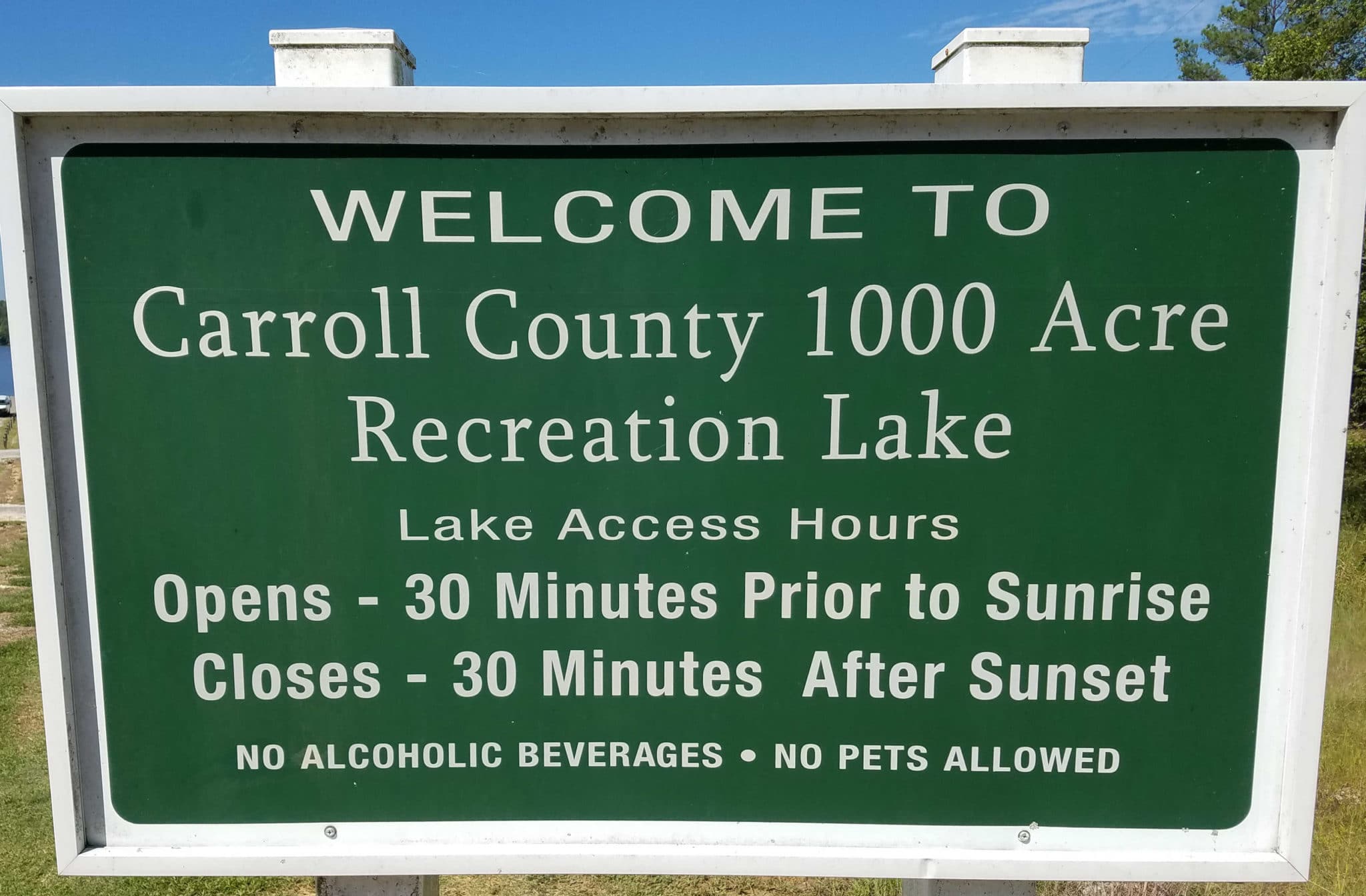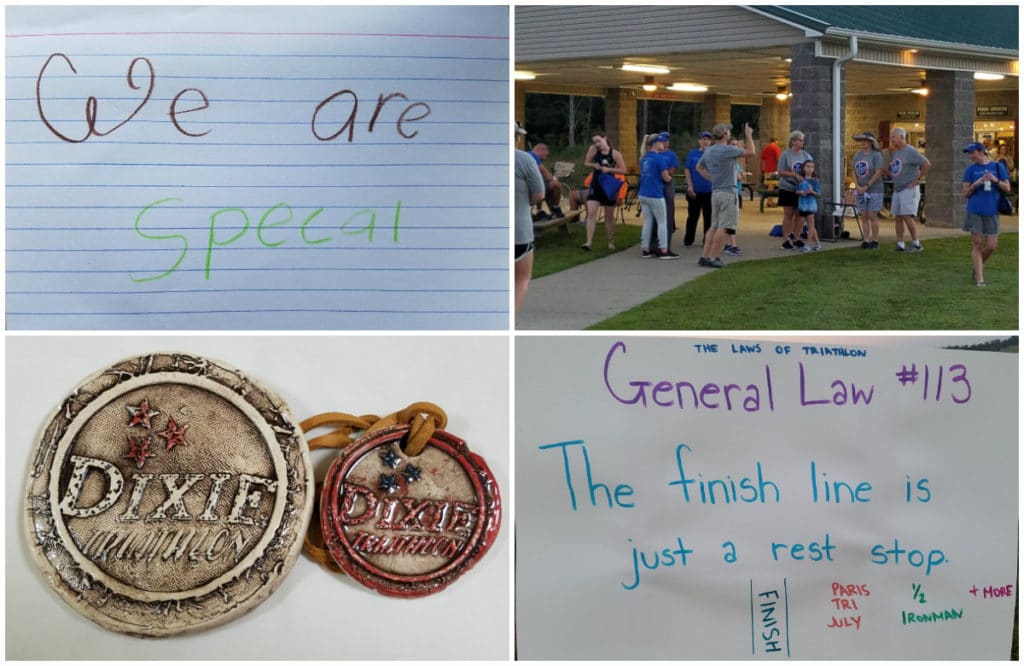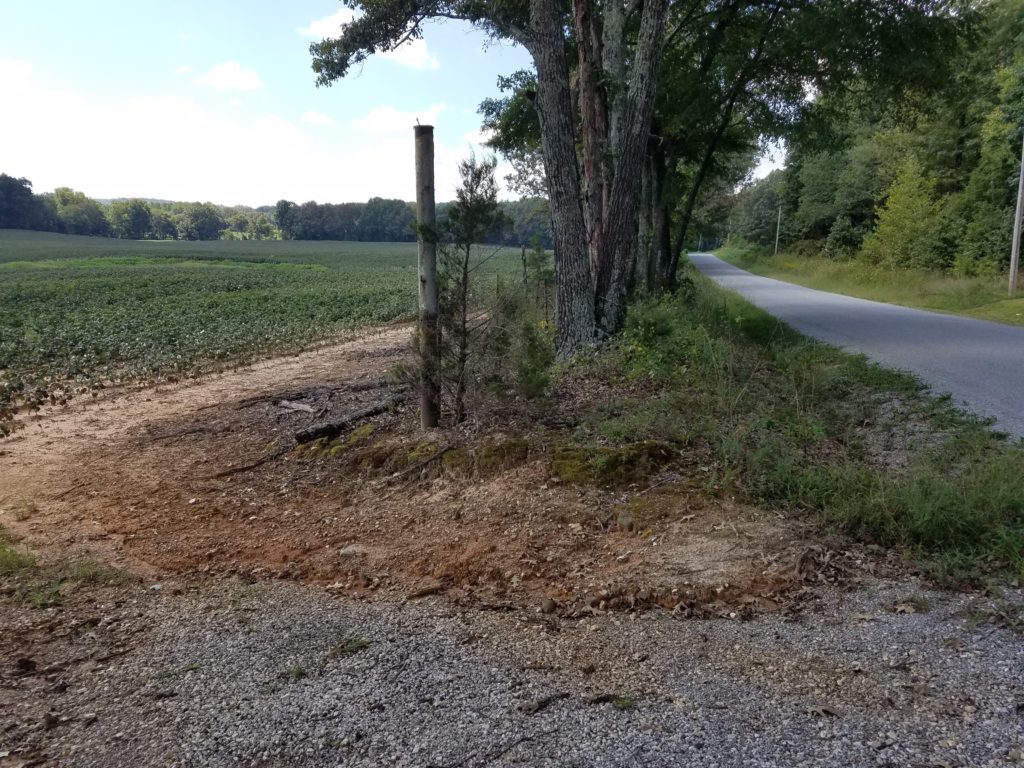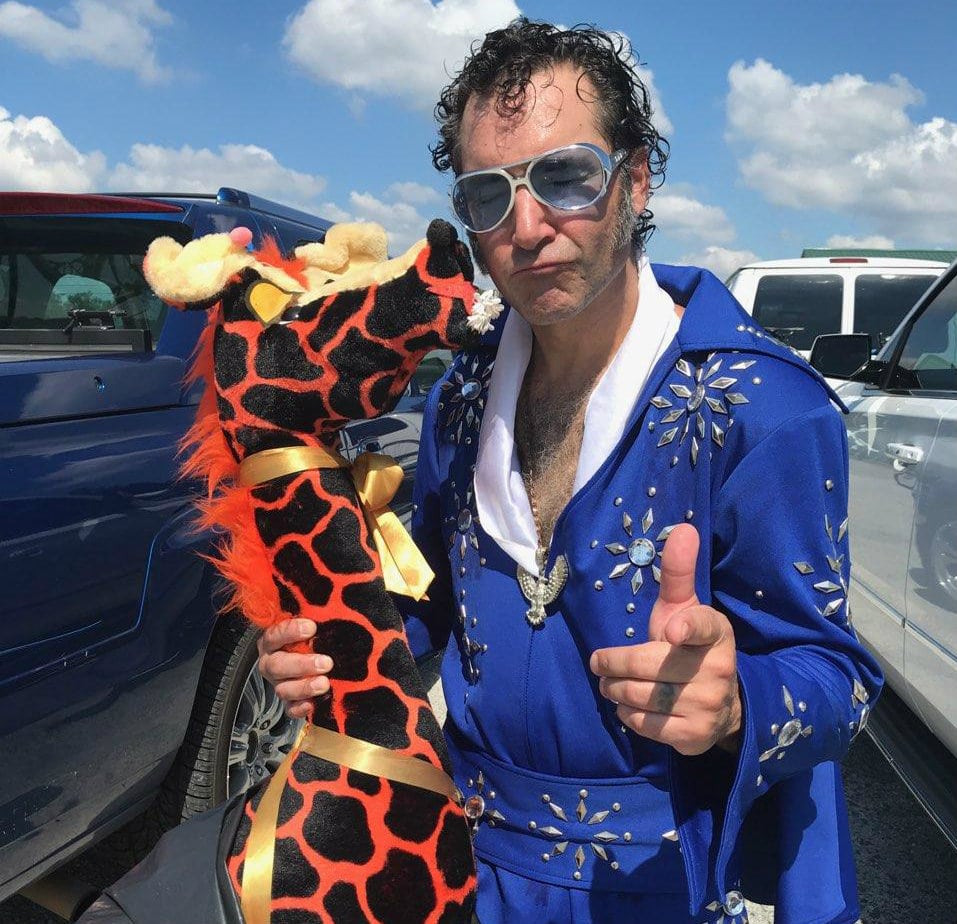Triathlon Across the USA: State #38-Tennessee

Huntingdon, Tennessee; September 15, 2018 – Dixie Triathlon, Carroll County 1000 Acre Recreation Area.
Travel to the Tennessee Triathlon
Joy and I used the week between the Hocking Hills Sprint Triathlon (Logan, Ohio) and the Tennessee triathlon to visit the Creation Museum and Ark Encounter and to camp at Big Bone Lick State Park, all in northern Kentucky.
Meanwhile, my searches for a hotel near the location of the Dixie Triathlon the next weekend had turned up nothing. The few hotels in the communities around Huntingdon were full on Friday night.
As we entered Tennessee on Thursday afternoon, we stopped at one of the first visitor’s centers. My goal was to find a camping site near the race venue. One of the closest options near Huntingdon was Natchez Trace State Park, around 45 minutes drive from the Carroll County Recreation Area.
While checking out camp sites within Natchez Trace State Park, we stumbled upon Pin Oak Lodge. The lodge provided a clean and comfortable air-conditioned room (much preferred since it was hot and humid outside), a restaurant, and a swimming pool, all among pine trees and with the view of a lake in the background.
First Dixie Triathlon
This was the inaugural running of the Dixie Triathlon. This race had been the dream of a local triathlete, Dr. Volker Winkler. Sadly, Dr. Winkler did not see his dream come true as he died unexpectedly earlier in the year.
However, in his honor, Carroll County officials and residents poured their hearts into making this event a success. McKenzie Medical Center, the clinic that Dr. Winkler helped found, served as the title sponsor of the race. The Dixie Carter Performing Arts Center in Huntingdon was the presenting sponsor.
Filled to Capacity
Every one of the 300 spots for the race was filled, despite this being the Dixie Triathlon’s first year.
Besides, the number and enthusiasm of volunteers supporting the athletes spoke volumes about the commitment of the community to the triathlon. Personal notes from Huntingdon Middle School students in the race packets and the handmade signs along the race course added to the welcoming feeling.
To top it off, all participants received handcrafted ceramic finisher medals produced in the Dixie Performing Art Center’s Mudslingers Pottery Studio.

Two Races in One
The Dixie Triathlon, managed by Above The Fold Events & Sport Promotions, Franklin, Tennessee, included both sprint and Olympic distances. There was also an option to compete in the sprint distance as a relay team.
Distances for the individual legs of this USAT-sanctioned sprint triathlon were:
- Swim: 0.31 mile (500 m)
- Bike: 16 mile (25.7 km)
- Run: 3.1 miles (5 km)
Transition Area Setup
The transition area was setup in a grassy area in front of the lake next to the boat ramp and dock. We chose our area on a ‘first come, first served’ basis, with all sprint racers on the side of the main aisle closest to the lake.
I was one of the first people to arrive at the race. Even though we arrived before the official opening of the transition area at 5:45 am, we were not the first. Nevertheless, I had a good location, just one bike position off the main aisle.
In setting up my transition area, I did what I have always done for a quick transition – set my helmet upside down, centered on the aerobars. I set my clear safety glasses inside the helmet, lenses downward and bows standing upward.
Checking back a little later, I found the helmet lying on the ground. Now, however, my glasses were in two pieces – the lenses and the frame.
I didn’t see anything to suggest that the glasses were broken. However, without my reading glasses, I couldn’t see any possibility of putting the two pieces back together. Fortunately, Joy found the solution and reassembled the two pieces.
I returned the glasses to the helmet, still in the transition area. However, this time, I left the helmet and glasses sitting on the ground next to the front bike tire. Just before the beginning of the race, when the transition area was ready to be closed, I put the helmet with glasses back onto the aero-bars.
Triathlon tip: During the setup of transition, plan for items in your personal space to be moved. Just before the close of transition, reinspect the area and reposition any of the items that have been moved.
Pre-Race Ceremony
After race director Joe Fleenor reviewed key points of the race course, we all joined Carroll County mayor, Joseph Butler, in a prayer thanking God for the beauty of His creation and asking for the safety of the participants. Katie Hodges of the Miss Dixie Performing Arts Center concluded the pre-race ceremony with the singing of the national anthem.
Swim
The water temperature was over 81°F so, according to USAT rules, wetsuits were not allowed.

I have learned the hard way to always check the bottom of the lake before the race. Lake bottoms vary considerably, some are rocky, some are muddy, and some are slippery. Today, we were swimming in a lake with an uneven, clay bottom that made walking into and out of the water tricky.
Wave Starts
Participants started in waves by distance, age groups, and gender. All the Olympic distance groups started first. As the first of the Olympic triathletes completed their swim, the male sprint distance racers started according to their age groups. I started in the group of twenty-six males age 50 and over.
About a minute and a half before the start of our wave, we walked onto the dock and jumped into the water, facing the first yellow buoy. The water was deep enough that I never touched bottom upon jumping in.
The rectangular shape of the sprint distance swim course required three left turns. The first two turns were around yellow buoys shown in the picture above. About 75 yards after making the last left turn, the one around the lone orange buoy, we reached the exit.
The steep drop-off of the bottom meant we could swim within a few feet of shore before touching bottom, one already determined to be uneven and slippery. Thankfully, volunteers stationed at the exit helped racers with their footing as they left the water.
Triathlon tip: In open water swims, it is helpful to swim as close to the exit as possible, especially when the bottom is difficult to walk on.
Bike
The mount location for the bike was also unique in that it sloped downward in two directions at the same time – away from the transition area and downward toward the lake. After riding out of the mount area, there was a short flat section of road during which I slipped my feet into the bike shoes.
The bike course continued out of the Carroll County 1000 Acre Recreation Area through a small hill onto the road leading into the area. The continuous series of hills took us along country roads past wooded areas and fields of soybeans and cotton (pictured below).
We continued into and through the center of Huntingdon, past the Dixie Carter Performing Arts Center and the Carroll County Courthouse. From there, we were back on another series of paved country roads.
The ‘Surprise’
The ‘surprise’ for the sprint competitors mentioned by race director Joe Fleenor during the opening announcements was as feared – a hill of the grade and length that required walking the bike up the last portion of the hill. (I would later learn that my bike frame was cracked. This, in turn, led to the rear wheel brake dragging on the rim.)
During the walk, I commiserated with a man of similar age who walked along with me. He informed me that he had known what was coming because he had ridden the course during training.
We reminded each other that triathlon is, at least for us, a hobby.
Time Wasters
Two events made my time on the bike course longer than necessary. The first was my chain coming off the gears as I downshifted before a steep hill.
Reinstalling the chain required first flipping the bike upside down. In this position, I could free the chain that had become wedged between the frame and gear. With the chain loose, it was a simple matter of flipping the bike right side up and resetting the chain on both sets of gears.
It seemed too risky re-clipping my shoes into the pedals while going uphill. Therefore, I turned the bike around and coasted downhill while clipping my shoes into the pedals. Once my shoes were clipped to the pedals, I made a U-turn to rejoin the race during a break in the flow of bikers.
The second cause of wasted time was misreading a sign containing an arrow marking the bike course. Thinking that I had continued onto the course for the Olympic distance, I turned around. Immediately, a volunteer yelled out for me to turn back around and make a right turn at the next intersection.
Run
The temperature at the start of the race was 72°F with a relative humidity of 89%. By the time I hit the run course, the temperature was in the high 80s°F.
The combination of temperature, humidity, and hills made this also one of the toughest runs. Senior triathlete and personal trainer, Jeanne Minder, later explained. She told me I had not trained enough in these conditions of heat, humidity, hills, etc. Another lesson to take from this race.
After the Tennessee Triathlon
Eavesdropping on conversations while re-hydrating after the race, I was comforted to hear from other seasoned triathletes from the southeast part of the USA say that this was ‘the’ or ‘one of the’ hilliest bike courses of a triathlon. Of course, I also overheard one guy say that people from ‘eastern Tennessee would not even consider this course to be hilly’.
The race committee provided a generous and diverse table of foods – pizza, donuts, bananas, oranges, and chips – and soft drinks and water for us to rehydrate and recover.
Our Next Destination
Before the Georgia triathlon the next weekend, we headed toward The Villages, Florida for a week with friends, Don & Sue. The stop in Florida would also be the end of the trip for the stuffed giraffe which had hitchhiked a ride in the back of our van. The giraffe would take up residence in central Florida with her owner, Debby P.
Race Firsts
- First time taking part in an inaugural triathlon.
- Riding past cotton fields was another first.
- This was the first triathlon in which I lost time on the bike course because I misread a course marker.
How Do You Prepare For Different Race Conditions?
How do you prepare to race in high temperature and humidity if you live in an area in which these do not occur? Share your thoughts in the Comments below.


